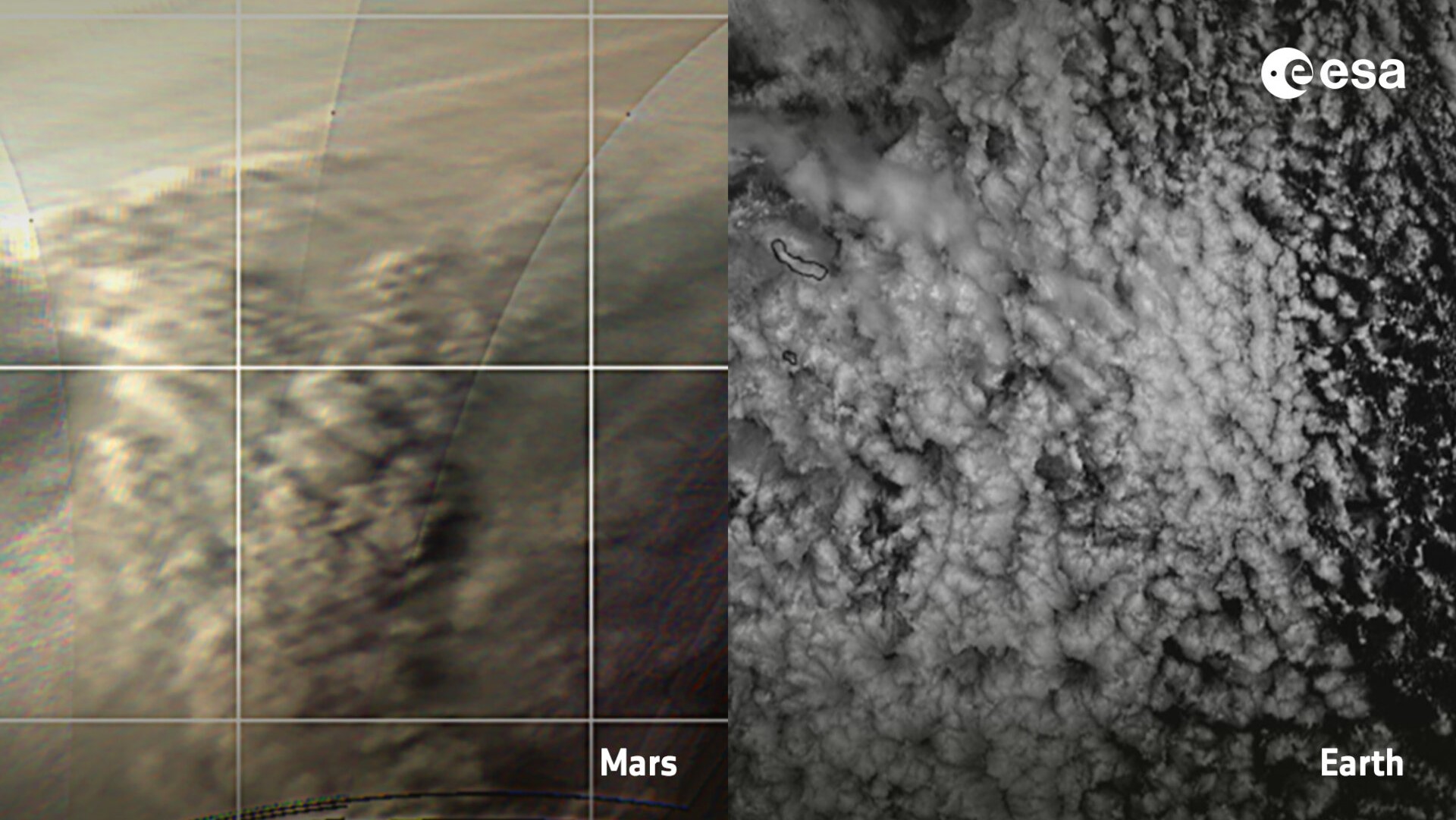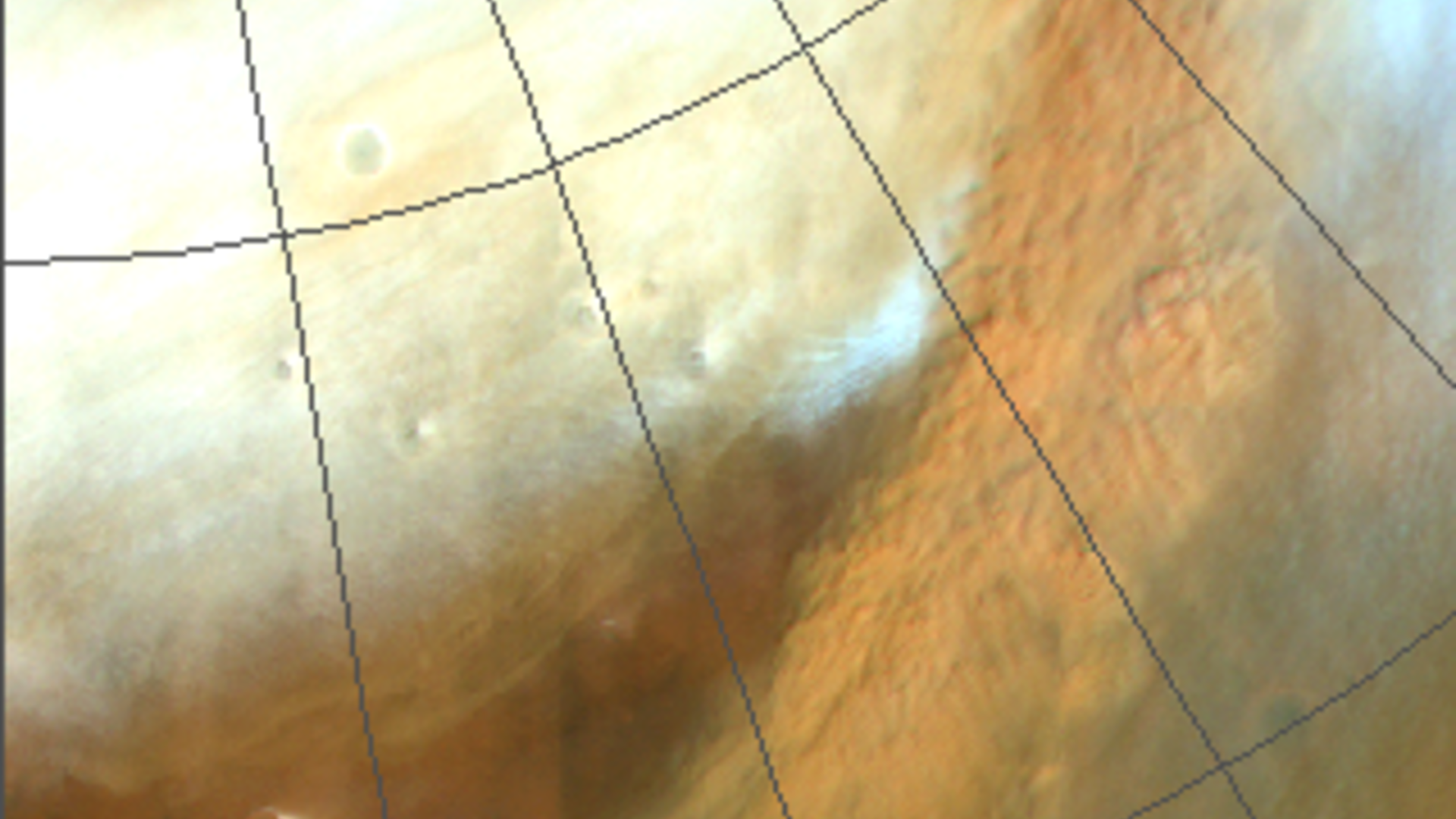Mars' clouds are strangely Earth-like, despite wildly different atmospheres

Despite having radically different atmospheres, Mars and Earth seem to have similar cloud patterns, hinting that the features may form in much the same way.
The observations, obtained by the European Space Agency's (ESA) Mars Express spacecraft and NASA's Mars Reconnaissance Orbiter, were unexpected. Perhaps most surprising to scientists was that the clouds observed over the dry and arid atmosphere of Mars resembled those found in very different environments on Earth.
"When thinking of a Mars-like atmosphere on Earth, one might easily think of a dry desert or polar region," Mars Express project scientist Colin Wilson said in a statement. "It is quite unexpected then, that through tracking the chaotic movement of dust storms, parallels can be drawn with the processes that occur in Earth's moist, hot and decidedly very un-Mars-like tropical regions."
Related: NASA's Curiosity rover spots strange, colorful clouds on Mars
For the research, the scientists looked at two dust storms that happened near the Martian north pole in the spring of 2019. To observe the storms from orbit around the Red Planet, they viewed images taken by Mars Express' Visual Monitoring Camera (VMC) and High-Resolution Stereo Camera (HRSC) and MRO's Mars Color Imager.
The VMC images show the storms growing and then disappearing in a cycle that exhibits common features and shapes as it is repeated over periods of days. Visible in the wider-view HRSC images are spiral shapes with lengths between around 1,600 and 3,200 miles (1,000 to 2,000 kilometers). These spirals seem to form in the same ways as extratropical cyclones seen at midlatitudes and polar latitudes on Earth.
The images also reveal that dust storms on Mars are composed of regularly spaced, smaller cloud cells that are arranged like pebbles, forming a garden-path-like texture that is also seen in clouds over Earth.
Get the Space.com Newsletter
Breaking space news, the latest updates on rocket launches, skywatching events and more!
These patterns are created when hot air rises and denser, cool air falls in cell-like units — a phenomenon called closed-cell convection. As hot air rises through the center of these cells, cool air falls through "pathways" that form in gaps between the individual cells, the researchers explained.

On Earth, this convection causes clouds to form because rising hot air contains water, which then condenses and falls as rain. In the dry and arid environment of Mars, however, these rising hot-air columns carry dust. As the air cools and sinks, it carries less dust. As a result, cells form over Mars with a familiar granular pattern seen in the clouds over Earth, albeit with a dusty, rather than watery, composition.
The dust cells seen over Mars are useful as a measurement tool, as their movement in sequences of images allows scientists to measure Martian wind speeds. This process has revealed winds blowing at up to 87 mph (140 kph); these high-speed winds cause the convection cells to be elongated in the direction the winds blow.
The lengths of the shadows in images taken with VMC, when measured and compared with the known position of the sun, also revealed the altitude of the Martian dust clouds — around 4 to 7 miles (6 to 11 km — and showed that the convention cells are around 12 to 25 miles (20 to 40 km) wide.
"Despite the unpredictable behavior of dust storms on Mars and the strong wind gusts that accompany them, we have seen that within their complexity, organized structures such as fronts and cellular convection patterns can emerge," Agustín Sánchez-Levaga, VMC science team leader and lead author of the study, said in the statement.

Earth and Mars aren't the only places in the solar system where such cellular convection is seen; ESA's Venus Express spacecraft spotted similar patterns in Venusian clouds.
"Our work on Mars dry convection is a further example of the value of comparative studies of similar phenomena occurring in planetary atmospheres in order to better understand the mechanisms underlying them under different conditions and environments," Sánchez-Levaga said.
This insight into the clouds of Mars gives planetary scientists a better understanding of the dynamics of the Martian atmosphere. Moreover, the knowledge of Martian dust storms could help inform future missions to the Red Planet.
Dust storms can block light from the sun that is needed to power the solar cells of robotic rovers that explore the Martian surface. The potentially damaging effects of dust storms on Mars were demonstrated in 2018, when a planet-wide event blocked out sunlight and coated the solar panels of the Opportunity rover with dust, ending its mission.
Predicting the evolution of such dust storms could protect solar-powered missions against these powerful natural events and even help future Mars astronauts deal with dust storms.
The team's research was published Tuesday (Nov. 15) in the journal Icarus.
Follow us on Twitter @Spacedotcom or on Facebook.
Join our Space Forums to keep talking space on the latest missions, night sky and more! And if you have a news tip, correction or comment, let us know at: community@space.com.

Robert Lea is a science journalist in the U.K. whose articles have been published in Physics World, New Scientist, Astronomy Magazine, All About Space, Newsweek and ZME Science. He also writes about science communication for Elsevier and the European Journal of Physics. Rob holds a bachelor of science degree in physics and astronomy from the U.K.’s Open University. Follow him on Twitter @sciencef1rst.









